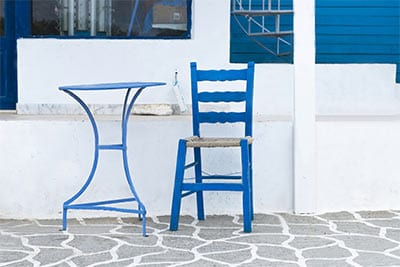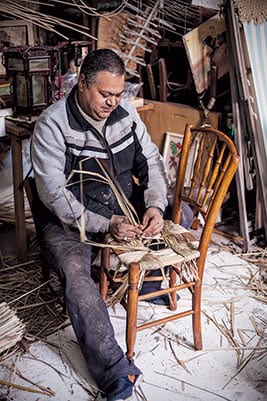America has fast-food chains. Greece has tavernas. While both offer inexpensive food (or, in the case of fast-food chains, food-like substances), their operational philosophy could not be more different
This difference is epitomized by their respective seating. The fast food chair is uncomfortable; it is designed to be that way. The seat is hard plastic. This guarantees you’ll scarf down your meal and get out. The chair is bolted to the floor. This ensures that social interaction is kept to a minimum – no pulling up a chair to join a larger group.
By contrast, the classic Greek taverna chair is made for comfort. Its rush seat is soft. The back slats provide support as well as ventilation. The braces at the base lend stability (and a place to prop your feet) – stability for leaning in to participate in conversation or to help oneself to a meze in the center of the table. Plus it is light; chose your table and sit on down.
Greek people can spend hours at the taverna, eating their meals, drinking their ouzo, reading their paper and talking with friends. In a popular tavernas, there is at least one card game going at any time. If you prefer tavli (backgammon) you can usually find a set or two behind the bar.

Tavernas were just as popular in ancient Greece as they are in Greece today. Back then they were called kapeleion.
Commenting on the ubiquity of tavernas in Greece and alluding to the militant Spartans, whose citizens were fed from common messes, Diogenes the Cynic said “tavernas are the canteens of Attica”. Tavernas were a regular feature in the comedies of Aristophanes with their staff being a frequent target of his jokes.
Unfortunately, no example of an ancient taverna chair survives.
Greek people can spend hours at the taverna, eating their meals, drinking their ouzo, reading their paper and talking with friends. In a popular tavernas, there is at least one card game going at any time. If you prefer tavli (backgammon) you can usually find a set or two behind the bar
Today Athanasopoulos familiy continues the craft of wickerwork in the traditional way. Their core business is to build and repair the wooden greek tavern chair.
On the narrow sidewalk on the corner of Lepeniotou and Leokoriou Street you can find a collection of handmade wooden chairs. Next to the shop entrance a steep staircase leads down to the workshop of Yannis Athanasopoulos. A friendly voice is calling us: “ela mesa” – come in! A middle aged man, tanned and of impressive built, introduces himself as Yannis. He is seated on a stool, holding a chair frame between his strong thighs. With meditative calm he is weaving the dry reed row by row into the wooden frame, creating a solid seat.

Two naked fluorescent tubes bath the crammed basement in sallow light. The space is at the same time workshop and storage – piles of broken chairs, furniture, lamps and all kinds of antiquities everywhere. With a sweeping gesture Yannis tells us: “This is my next order, these are all chairs from a kafenion.” The owner of the kafenion is a loyal customer; time and again he is taking his broken chairs to Yannis for repair. In one corner materials like wood and reed are neatly arranged. The smell of dried grass and mouldy walls blends with sweat of hard work.
Yannis learned the craft from his mother Katerina. In 1965 she came with her parents from the region of Macedonia to settle in Athens and establish a business of wickerwork. Katharina, a courageous woman, proudly says „with my grandson, Konstantinos, we are passing the knowledge to our fourth generation“. The family business – mother, son and grandson – is specialised in the weaving of chairs as well as mending old ones and other furniture, including the ordinary Greek tavern chair but also chairs with delicate Viennese netting.